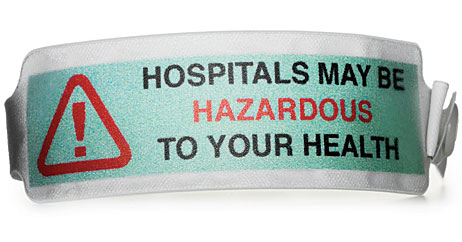Alarming Trend: Medical Errors Have Increased in the U.S.
By Editor, on April 16th, 2011

A
new editorial in The Lancet medical journal cites staggering statistics
that medical errors now occur in as many one-third of all U.S.
hospitalizations.
The editors present other attention-getting statistics from several
scientific studies establishing that medical errors remain a serious
problem in the U.S. and appear to have increased over the last 10 years,
despite national attention called to this problem.
The Lancet editors ask, “Why?” And, they make some suggestions that
should well be considered by medical professionals, patients and
caregivers, and policy makers in the U.S.
Related: Dr Oz Busted!! Click Here
The Alarming Statistics:
The editorial, entitled, “
Medical errors in the USA: human or systemic?“, appears in the
April 16, 2011 Issue of The Lancet.
It cites and describes the findings of several published studies on
medical errors in the U.S. by recognized U.S. scientific and
professional sources. Among them are the following:
- The US Institute of Medicine’s 1999 report, To Err is Human: Building a Safer Health System,
estimated that avoidable medical errors contributed annually to
44,000—98,000 deaths in US hospitals. Hospital errors were reported to
constitute the eighth leading cause of death nationally, accounting for
more U.S. deaths than breast cancer, AIDS, and motor-vehicle accidents.
This drew national attention to the problem.
- Yet, more than 10 years later, the problem of medical errors
remains and seems to have increased. A new study reported in the April,
2011 issue of Health Affairs,
found that by one measure, medical errors occur in as many as one-third
of hospital admissions in the U.S., and may be ten times greater than
previously measured. “The most common are medication errors, followed
by surgical errors, procedure errors, and nosocomial infections,”
according to The Lancet’s review of the study.
The study, conducted by scientists and professionals at three leading
U.S. medical schools as well as at the Institute for Healthcare
Improvement, compared three different methods commonly used for
measuring “adverse events” in hospitals: (i) voluntary reporting, (ii)
the Agency for Healthcare Research and Quality’s Patient Safety
Indicators (which rely on automated review of discharge codes to detect
adverse events), and (iii) the Global Trigger Tool pioneered by the
Institute for Healthcare Improvement (based upon independent review of
medical charts, with follow up investigation where indicated).
The study found that this third method measured at least ten times
more confirmed serious medical errors than did the other two methods.
As observed by The Lancet’s editorial, “This finding suggests that the
two currently used methods for detecting medical errors in the USA are
unreliable, underestimate the real burden, and also risk misdirection of
present efforts to improve patient safety.”
-
- A study reported in the November 25, 2010 issue of the New England Journal of Medicine,
also confirmed that medical errors in U.S. hospitals are a serious
problem. The study, conducted by lead author Christopher Landrigan,
M.D., M.P.H. of the Department of Medicine, Brigham and Women’s
Hospital, Boston, Massachusetts, and a group of doctors from Harvard
Medical School, Standford University School of Medicine, and the
Institute for Healthcare Improvement, reported that even in places where
local governments have made efforts to improve safety of inpatient
care, such as in hospitals in North Carolina, the high rate of detected
medical errors did not change over a 5-year period between 2002 and
2007.
- A November, 2010, document from the Office of the Inspector General of the Department of Health and Human Services
reported that one in seven Medicare beneficiaries have complications
from medical errors when hospitalized, and that these medical errors
contribute to about 180,000 deaths of patients per year.
- A study by Jill Van Den Bos and other professionals of Milliman’s Denver Health practice reported in the April, 2011 Issue of Health Affairs
found that the measurable cost of US medical errors amounted to US
$17.1 Billion in 2008 (0.72% of the $2.39 trillion spent on health care
that year). Ten types of error accounted for more than two-thirds of the
total cost of medical errors. The top two most costly medical errors
are postoperative infections and pressure ulcers. The three most common
medical errors were pressure ulcers, post-operative infections, and
postlaminectomy syndrome.
- Another study, conducted by John Goodman and associates of the
National Center for Policy Analysis in Dallas, TX and also reported in
the April, 2011 Issue of Health Affairs,
reported that medical errors cause as many as 187,000 deaths in
hospitals each year, and 6.1 million injuries, both in and out of
hospitals in the U.S. This study estimated that the social costs, in
lives lost and disabilities caused, from these medical errors amounted
to between $393 Billion to $958 Billion in 2006, equivalent to 18% to
45% of total US health-care spending in that year. These authors
recommended as a possible solution that patients should be “offered
voluntary, no-fault insurance prior to treatment or surgery [so that
they] would be compensated if they suffered an adverse event—regardless
of the cause of their misfortune—and providers would have economic
incentives to reduce the number of such events.”
http://www.helpingyoucare.com/12784/alarming-trend-medical-errors-have-increased-in-the-u-s
http://www.helpingyoucare.com/12784/alarming-trend-medical-errors-have-increased-in-the-u-s
 Neurosurgery Salaries
Neurosurgery Salaries

 A
new editorial in The Lancet medical journal cites staggering statistics
that medical errors now occur in as many one-third of all U.S.
hospitalizations.
A
new editorial in The Lancet medical journal cites staggering statistics
that medical errors now occur in as many one-third of all U.S.
hospitalizations.


